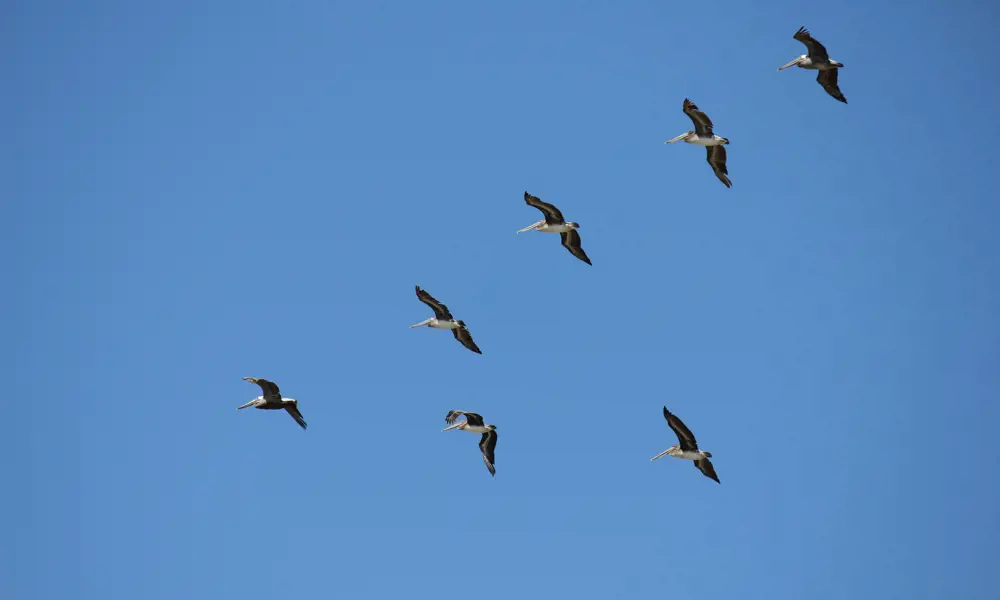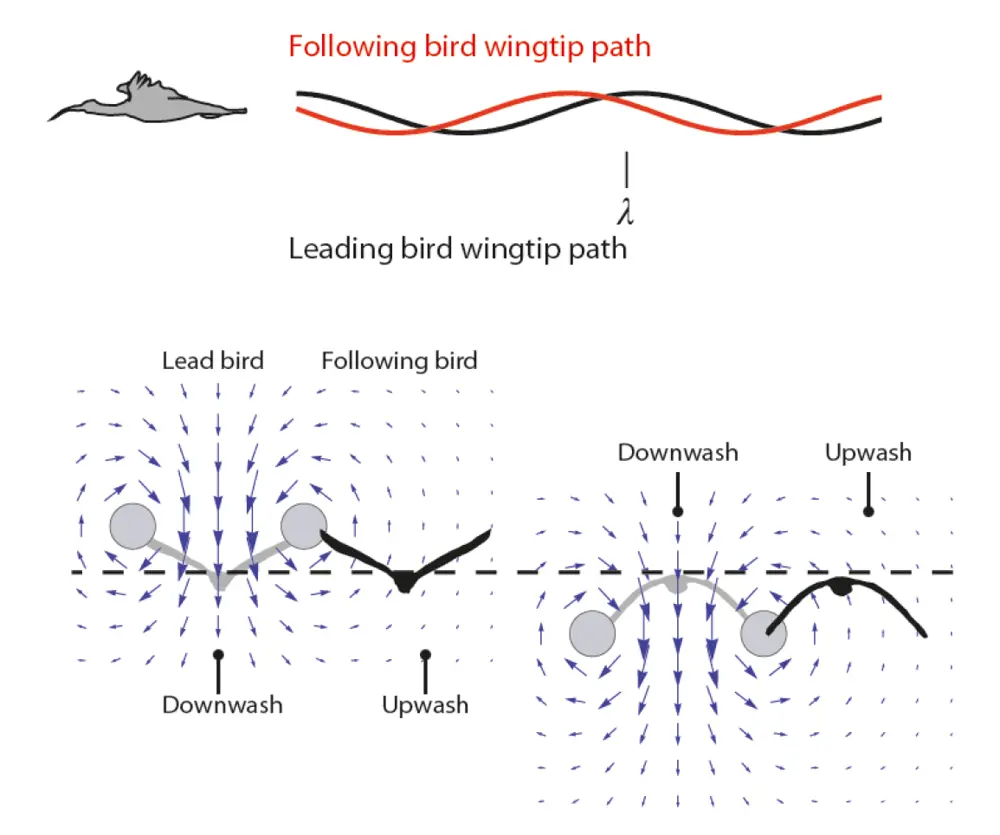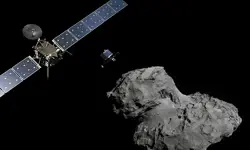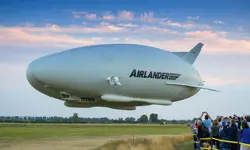
Birds flying in a V formation
Although it had long been thought that flying in V formation was more efficient, it was only in 2001 that researcher Henri Weimerskirch first showed, by fitting pelicans with heart-rate monitors, that birds flying in the back of a V formation had lower heart rates and hence energy consumption. It was assumed that the reason for this was that, apart from the first bird in the formation, all the birds fly in the upward-moving air produced by the wings of the bird ahead. However, how they did this was unknown until a study in 2014 used a flock of northern bald ibises that had been trained to follow a microlight.
birds are not only visually aware of where the others in the flock are, but are also able (somehow) to sense the direction of the airflow from the vortices shed from the edge of the wing ahead
The study found that birds are not only visually aware of where the others in the flock are, but are also able (somehow) to sense the direction of the airflow from the vortices shed from the edge of the wing ahead. By positioning themselves accordingly, and by adjusting their rate of flapping, they can make maximum use of the upward-moving air generated by the bird in front. During flight, birds move their wings at a slight angle that deflects the air downwards, so that air flows faster over the wing than underneath. Air pressure builds up beneath their wings and the pressure above reduces, and this difference in pressure produces lift. Flapping the wings creates additional forces: the upward force, thrust, and the downward power stroke.
During the downward stroke, the wing’s angle is even steeper and provides the majority of the thrust. This creates a very brief downward dive through the air, using the bird’s own weight to move forward, but it remains airborne as the wings continue to generate lift. The bird folds its wing inwards slightly during each upstroke, which reduces resistance.

By positioning themselves accordingly, birds can make use of the ‘upwash’ generated by the bird flying in front of them © Reprinted by permission from Springer Nature: Nature, ‘Upwash exploitation and downwash avoidance by flap phasing in ibis formation flight’, Steven J. Portugal, Tatjana Y. Hubel, Johannes Fritz, Stefanie Heese, Daniela Trobe et al. 2014
With each flap a rotating vortex of air rolls off each wingtip and, by positioning itself in the upward part of this, the following bird gains free lift similar to how a glider can climb or maintain height indefinitely in rising air. The birds clearly need to avoid each other’s downwash, as that pushes them down and would result in them using extra energy. It is not yet known how they sense the upwash, but it may be that the wing feathers are themselves the sensors, or perhaps the birds also sense the total energy needs of flying and therefore accommodate themselves to the most comfortable rhythm.
in a V formation of 25 members, each bird can achieve a reduction of induced drag and increase their range by 71% as a result
In large birds like the ibis, each bird flies around a metre behind the bird in front, and a metre off to the side. They tend to swap positions and the front bird is rotated in a timely cyclical fashion so that flight fatigue is spread equally throughout the flock (much like cyclists in a peloton). Early studies had found that in a V formation of 25 members, each bird can achieve a reduction of induced drag and increase their range by 71% as a result. The 2014 study showed that birds’ heart rates decreased when they were flying together in a V formation, demonstrating that the formation saves energy.
Many air forces employ the V pattern during military flight missions and it was used as early as the First World War, where the ‘Vic’ formation improved fuel efficiency and allowed pilots to see each other’s aircraft. More recently, it has been used in swarms of drones to extend range.
***
This article has been adapted from "How does that work? Birds flying in a V formation", which originally appeared in the print edition of Ingenia 75 (June 2018).
Keep up-to-date with Ingenia for free
SubscribeRelated content
Aerospace

ALMA – the high altitude observatory
The Atacama Large Millimetre/submillimetre Array (ALMA) is the largest and most expensive ground-based telescope built, revolutionising our understanding of stars and planetary systems. Building it in the Atacama Desert in Chile required the ingenuity of hundreds of engineers.

Communicating with outer space
The Royal Academy of Engineering awarded a team at BAE Systems the Major Project Award in June 2016 for their development of a powerful satellite modem system, pivotal in enabling the precise control of the pioneering Rosetta spacecraft and the first-ever soft landing of a spacecraft on a comet.

An aircraft like no other
The Airlander made headlines when it embarked on its first test flight in August 2016 as the world’s largest aircraft. Chris Daniels at Hybrid Air Vehicles Limited, and David Burns, Airlander’s Chief Test Pilot, talk about the engineering that helped it reach this stage and plans for the craft’s future.

Q&A: Lucy Harden
Lucy Harden is a mechanical engineer on BAE Systems’ Digital Light Engine Head-Up Display development programme. She devises innovative solutions for pilots to display essential flight information that sits directly in their line of sight and is overlaid onto the real world.
Other content from Ingenia
Quick read

- Environment & sustainability
- Opinion
A young engineer’s perspective on the good, the bad and the ugly of COP27

- Environment & sustainability
- Issue 95
How do we pay for net zero technologies?
Quick read

- Transport
- Mechanical
- How I got here
Electrifying trains and STEMAZING outreach

- Civil & structural
- Environment & sustainability
- Issue 95